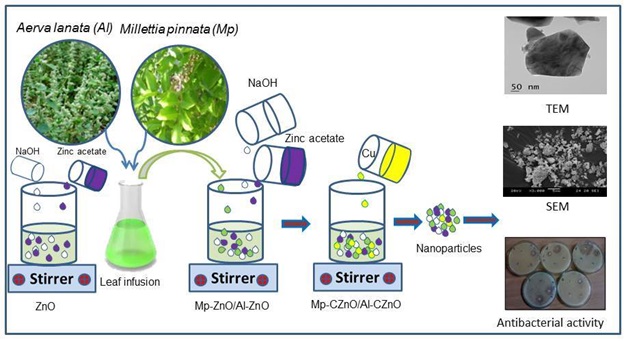
A green synthesis using a simple precipitation method produced zinc oxide (ZnO), leaf extractions of zinc oxide as Aerva lanata (Al-ZnO) and Millettia pinnata (Mp-ZnO), copper-doped Al-CZnO and Mp-CZnO nanoparticles (NAPs). They were characterized for their functional group, structural, antibacterial, and luminescence properties. The grown NAPs were examined by Ultraviolet-visible (UV-Vis), Photoluminescence (PL), Fourier Transform-Infrared (FT-IR) spectroscopy, X-ray diffraction (XRD), Scanning Electron Microscopy (SEM), Transmission Electron Microscopy (TEM) and antibacterial activity. The XRD analysis confirms that all NAPs have a hexagonal structure and no impurity phases other than Cu. In consequence of this, Cu ion has been successfully incorporated into the standard ZnO structure. The calculated crystalline size through the XRD pattern of pure ZnO, Al-ZnO, Mp-ZnO, Al-CZnO, and Mp-CZnO NAPs and the average grain size were 81.37, 52.08, 63.24, 37.54, and 30.71 nm, respectively. The optical absorption spectra show that adding Cu reduces the band gap. FTIR is used to assess the functional group and chemical interaction of leaf extraction and Cu-doped ZnO at various peaks. In addition, its functional groups are observed to correspond to the ZnO bands in all the samples. The microstructure analysis of SEM confirms that all the NAPs are agglomerated by adding the dopant, which turns into a particle-like structure. The antibacterial activity of the NAPs against Escherichia coli was measured using the agar well diffusion technique, and the optimum zone of inhibition (ZOI) was found to be 21 mm. Overall, the obtained results revealed that the Mp-CZnO NAPs is a novel and efficient bacterial pathogens present in the aqueous medium. Hence, it is a good representation for future biomedical applications.
Total file downloads: 14